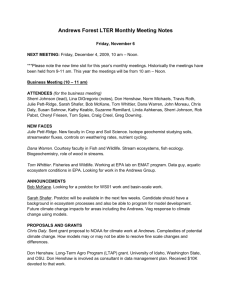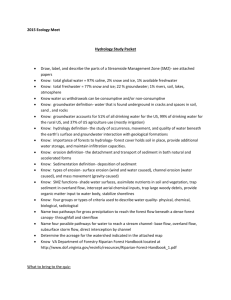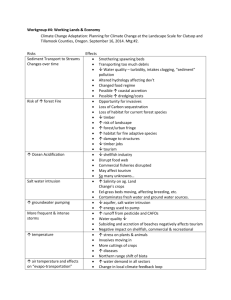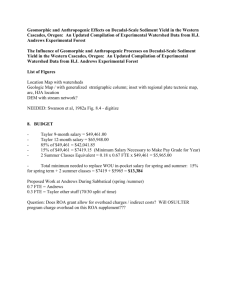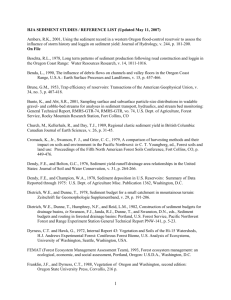The Earth Science program provides a liberal arts core education in
advertisement
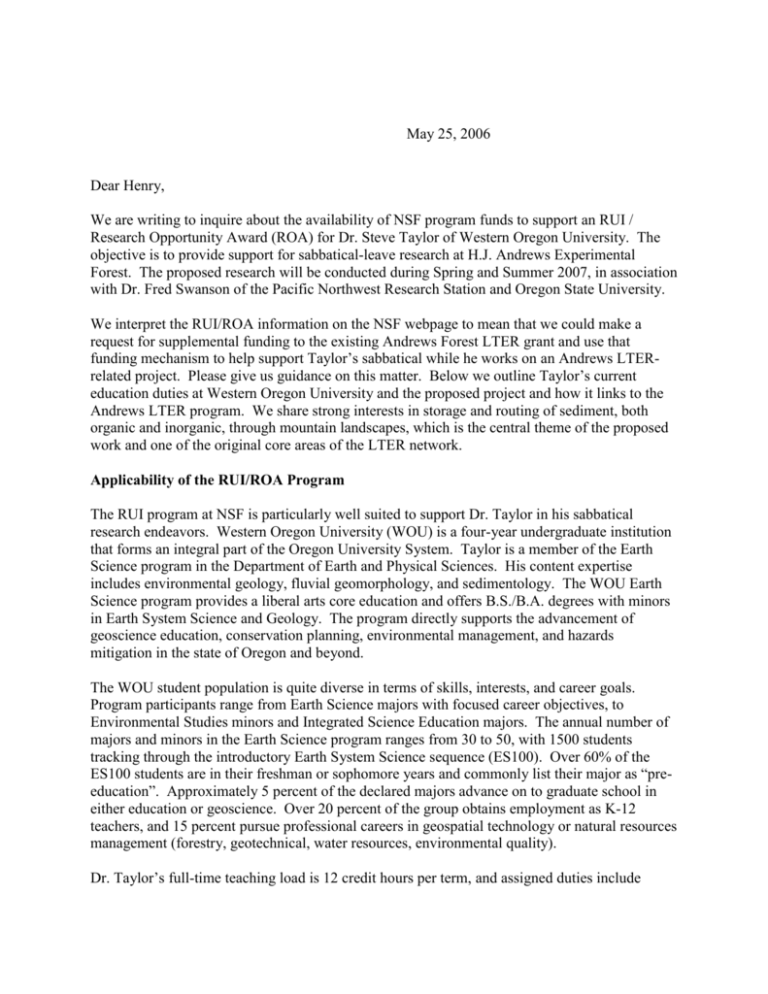
May 25, 2006 Dear Henry, We are writing to inquire about the availability of NSF program funds to support an RUI / Research Opportunity Award (ROA) for Dr. Steve Taylor of Western Oregon University. The objective is to provide support for sabbatical-leave research at H.J. Andrews Experimental Forest. The proposed research will be conducted during Spring and Summer 2007, in association with Dr. Fred Swanson of the Pacific Northwest Research Station and Oregon State University. We interpret the RUI/ROA information on the NSF webpage to mean that we could make a request for supplemental funding to the existing Andrews Forest LTER grant and use that funding mechanism to help support Taylor’s sabbatical while he works on an Andrews LTERrelated project. Please give us guidance on this matter. Below we outline Taylor’s current education duties at Western Oregon University and the proposed project and how it links to the Andrews LTER program. We share strong interests in storage and routing of sediment, both organic and inorganic, through mountain landscapes, which is the central theme of the proposed work and one of the original core areas of the LTER network. Applicability of the RUI/ROA Program The RUI program at NSF is particularly well suited to support Dr. Taylor in his sabbatical research endeavors. Western Oregon University (WOU) is a four-year undergraduate institution that forms an integral part of the Oregon University System. Taylor is a member of the Earth Science program in the Department of Earth and Physical Sciences. His content expertise includes environmental geology, fluvial geomorphology, and sedimentology. The WOU Earth Science program provides a liberal arts core education and offers B.S./B.A. degrees with minors in Earth System Science and Geology. The program directly supports the advancement of geoscience education, conservation planning, environmental management, and hazards mitigation in the state of Oregon and beyond. The WOU student population is quite diverse in terms of skills, interests, and career goals. Program participants range from Earth Science majors with focused career objectives, to Environmental Studies minors and Integrated Science Education majors. The annual number of majors and minors in the Earth Science program ranges from 30 to 50, with 1500 students tracking through the introductory Earth System Science sequence (ES100). Over 60% of the ES100 students are in their freshman or sophomore years and commonly list their major as “preeducation”. Approximately 5 percent of the declared majors advance on to graduate school in either education or geoscience. Over 20 percent of the group obtains employment as K-12 teachers, and 15 percent pursue professional careers in geospatial technology or natural resources management (forestry, geotechnical, water resources, environmental quality). Dr. Taylor’s full-time teaching load is 12 credit hours per term, and assigned duties include curriculum development, research, and service to the community. Of the above task areas, teaching occupies approximately 70% of the work load, followed by service and scholarship in decreasing order of time commitment. Given Taylor’s role at WOU and institutional demographics, the support provided by the RUI/ROA program at NSF offers a high potential to enhance geoscience education and research at the undergraduate level. In addition, it is anticipated that this project will make a valuable contribution to the research mission at Andrews Experimental Forest. Proposed Research Collaboration Study of many dimensions of long-term watershed behavior has been a central feature of the Andrew Experimental Forest research program for more than 50 years – most notably in the International Biological Program of the 1970s and Long-Term Ecological Research (LTER) program since 1980. The 10-ha Watershed 10 (clearcut in 1975) and its control, 9-ha Watershed 9 (mature and old-growth Douglas-fir forest) have been a centerpiece for work on hydrology, biogeochemical cycling, and soil/sediment routing in native and managed forests. The work on soil and sediment storage and transport addresses soil erosion, changes in nutrient capital, and disturbance themes that are important parts of the Andrews Forest LTER program. We propose to extend the interpretation and presentation of findings from studies of soil/sediment routing in WS9 and WS10 since the last publications 25 years ago (Cromack et al. 1978, Swanson et al. 1982). That earlier work posed hypotheses about changing rates of soil/sediment movement in the post-logging landscape, described soil/sediment storage and movement under forested conditions, and laid out conceptual and quantitative frameworks for assessing effects of forest disturbance on soil/sediment movement. Now we have a long (>30 yrs) record of post-logging sediment movement that we can use to test those hypotheses of biotic controls on soil/sediment movement and also document rates of soil loss and disturbance to hillslope and channel environments. Specifically, we propose to compile, analyze, and publish records of measurements of surface erosion (through 1987), dissolved constituents of precipitation and streamflow (cations, silica, and a few others) (to present), suspended and bedload sediment (to present), and debris flows (1986, 1996 events). These analyses will give annual measures of temporal variation in sediment discharge over nearly 40 years from a forested watershed and for 30+ years from a clearcut and reforesting watershed. We can examine influences of climate variability, including 50-year floods, and change in vegetation cover in terms of export of organic and inorganic dissolved and particulate matter. The findings can then be related to studies of biogeochemical cycling in these and other Andrews Forest experimental watersheds, and parallel studies at other LTER and similar sites. We will also compare findings from the sediment budget and routing studies to work at other sites. Concluding Statement The RUI/ROA program at the National Science Foundation seems very well suited to support Taylor to work with the Andrews Forest program. ROA funds will greatly enhance the proposed project at Andrews Experimental Forest, and this work would greatly benefit the Andrews Forest LTER research program and extend its education efforts. From our reading of the RUI/ROA guidelines it appears that supplemental funding to the LTER grant would be a potential funding mechanism – is this true? Please give us guidance as to how to proceed. Thank you very much for your time and consideration. Sincerely, Fred Swanson, U.S.D.A. Forest Service, Pacific Northwest Research Station Steve Taylor, Western Oregon University Literature Cited Cromack, K., Jr.; Swanson, F. J.; Grier, C. C. 1978. A comparison of harvesting methods and their impact on soils and environment in the Pacific Northwest. In: C. T. Youngberg (ed.). Forest soils and land use. Proc. Fifth North American Forest Soils Conf., Fort Collins, CO: 449-476 Swanson, F. J.; Fredriksen, R. L.; McCorison, F. M. 1982. Material transfer in a western Oregon forested watershed. In: Edmonds, Robert L., ed. Analysis of coniferous forest ecosystems in the western United States. US/IBP Synthesis Series 14. Stroudsburg, PA: Hutchinson Ross Publishing Company: 233-266.
